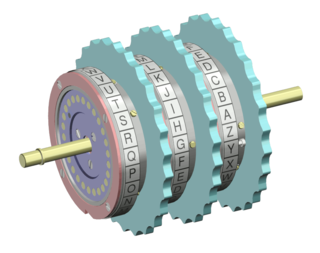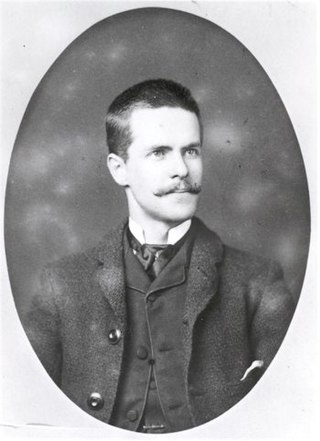Related Research Articles

An electric light, lamp, or light bulb is an electrical component that produces light. It is the most common form of artificial lighting. Lamps usually have a base made of ceramic, metal, glass, or plastic, which secures the lamp in the socket of a light fixture, which is often called a "lamp" as well. The electrical connection to the socket may be made with a screw-thread base, two metal pins, two metal caps or a bayonet mount.

An incandescent light bulb, incandescent lamp or incandescent light globe is an electric light with a filament that is heated until it glows. The filament is enclosed in a glass bulb that is either evacuated or filled with inert gas to protect the filament from oxidation. Electric current is supplied to the filament by terminals or wires embedded in the glass. A bulb socket provides mechanical support and electrical connections.

A Nixie tube, or cold cathode display, is an electronic device used for displaying numerals or other information using glow discharge.

In cryptography, a rotor machine is an electro-mechanical stream cipher device used for encrypting and decrypting messages. Rotor machines were the cryptographic state-of-the-art for much of the 20th century; they were in widespread use in the 1920s–1970s. The most famous example is the German Enigma machine, the output of which was deciphered by the Allies during World War II, producing intelligence code-named Ultra.

Sir Hiram Stevens Maxim was an American-born British inventor best known as the creator of the first automatic machine gun, the Maxim gun. Maxim held patents on numerous mechanical devices such as hair-curling irons, a mousetrap, and steam pumps. Maxim laid claim to inventing the lightbulb.

A neon lamp is a miniature gas-discharge lamp. The lamp typically consists of a small glass capsule that contains a mixture of neon and other gases at a low pressure and two electrodes. When sufficient voltage is applied and sufficient current is supplied between the electrodes, the lamp produces an orange glow discharge. The glowing portion in the lamp is a thin region near the cathode; the larger and much longer neon signs are also glow discharges, but they use the positive column which is not present in the ordinary neon lamp. Neon glow lamps were widely used as indicator lamps in the displays of electronic instruments and appliances. They are still sometimes used for their electrical simplicity in high-voltage circuits.

HLN is an American basic cable network. That is owned by CNN Worldwide, the network primarily carries true-crime programming, as well as limited live news programming.

Ticker tape was the earliest electrical dedicated financial communications medium, transmitting stock price information over telegraph lines, in use from around 1870 through 1970. It consisted of a paper strip that ran through a machine called a stock ticker, which printed abbreviated company names as alphabetic symbols followed by numeric stock transaction price and volume information. The term "ticker" came from the sound made by the machine as it printed.

A news ticker is a horizontal or vertical text-based display either in the form of a graphic that typically resides in the lower third of the screen space on a television station or network or as a long, thin scoreboard-style display seen around the facades of some offices or public buildings dedicated to presenting headlines or minor pieces of news. It is an evolution of the ticker tape, a continuous paper print-out of stock quotes from a printing telegraph which was mainly used in stock exchanges before the advance of technology in the 1960s.
The Phoebus cartel was an international cartel that controlled the manufacture and sale of incandescent light bulbs in much of Europe and North America between 1925–1939. The cartel took over market territories and lowered the useful life of such bulbs. Corporations based in Europe and the United States, including Tungsram, Osram, General Electric, Associated Electrical Industries, and Philips, incorporated the cartel on January 15, 1925 in Geneva, as Phœbus S.A. Compagnie Industrielle pour le Développement de l'Éclairage. Although the group had intended the cartel to last for thirty years, it ceased operations in 1939 with the outbreak of World War II. Following its dissolution, light bulbs continued to be sold at the 1,000-hour life standardized by the cartel.

One Times Square is a 25-story, 363-foot-high (111 m) skyscraper on Times Square in the Midtown Manhattan neighborhood of New York City. Designed by Cyrus L. W. Eidlitz in the neo-Gothic style, the tower was built in 1903–1904 as the headquarters of The New York Times. It takes up the city block bounded by Seventh Avenue, 42nd Street, Broadway, and 43rd Street. The building's design has been heavily modified throughout the years, and all of its original architectural detail has since been removed. One Times Square's primary design features are the advertising billboards on its facade, added in the 1990s. Due to the large amount of revenue generated by its signage, One Times Square is one of the most valuable advertising locations in the world.

Neon lighting consists of brightly glowing, electrified glass tubes or bulbs that contain rarefied neon or other gases. Neon lights are a type of cold cathode gas-discharge light. A neon tube is a sealed glass tube with a metal electrode at each end, filled with one of a number of gases at low pressure. A high potential of several thousand volts applied to the electrodes ionizes the gas in the tube, causing it to emit colored light. The color of the light depends on the gas in the tube. Neon lights were named for neon, a noble gas which gives off a popular orange light, but other gases and chemicals called phosphors are used to produce other colors, such as hydrogen (purple-red), helium, carbon dioxide (white), and mercury (blue). Neon tubes can be fabricated in curving artistic shapes, to form letters or pictures. They are mainly used to make dramatic, multicolored glowing signage for advertising, called neon signs, which were popular from the 1920s to 1960s and again in the 1980s.

The concept of television is the work of many individuals in the late 19th and early 20th centuries. The first practical transmissions of moving images over a radio system used mechanical rotating perforated disks to scan a scene into a time-varying signal that could be reconstructed at a receiver back into an approximation of the original image. Development of television was interrupted by the Second World War. After the end of the war, all-electronic methods of scanning and displaying images became standard. Several different standards for addition of color to transmitted images were developed with different regions using technically incompatible signal standards. Television broadcasting expanded rapidly after World War II, becoming an important mass medium for advertising, propaganda, and entertainment.

The Centennial Light is an incandescent light bulb, recognized as the oldest known continuously operating light bulb. It was first illuminated in 1901, and has only been turned off a few brief times since. It is located at 4550 East Avenue, Livermore, California, and is open to public viewing. Due to its longevity, the bulb has been noted by The Guinness Book of World Records, Ripley's Believe It or Not!, and General Electric. The light has been the subject of many TV shows and news reports along with at least 4 books, and has its own website.
The Floating Light Bulb is a 1981 Broadway play by Woody Allen. Semi-autobiographical, it focuses on a lower middle class family living in Canarsie, Brooklyn, New York City, in 1945.
Electron-stimulated luminescence (ESL) is production of light by cathodoluminescence, i.e. by a beam of electrons made to hit a fluorescent phosphor surface. This is also the method used to produce light in a cathode ray tube (CRT). Experimental light bulbs that were made using this technology do not include magnetic or electrostatic means to deflect the electron beam.

A timeline of United States inventions (1890–1945) encompasses the ingenuity and innovative advancements of the United States within a historical context, dating from the Progressive Era to the end of World War II, which have been achieved by inventors who are either native-born or naturalized citizens of the United States. Copyright protection secures a person's right to his or her first-to-invent claim of the original invention in question, highlighted in Article I, Section 8, Clause 8 of the United States Constitution which gives the following enumerated power to the United States Congress:
To promote the Progress of Science and useful Arts, by securing for limited Times to Authors and Inventors the exclusive Right to their respective Writings and Discoveries.

Word Lens was an augmented reality translation application from Quest Visual. Word Lens used the built-in cameras on smartphones and similar devices to quickly scan and identify foreign text, and then translated and displayed the words in another language on the device's display. The words were displayed in the original context on the original background, and the translation was performed in real-time without a connection to the internet. For example, using the viewfinder of a camera to show a shop sign on a smartphone's display would result in a real-time image of the shop sign being displayed, but the words shown on the sign would be the translated words instead of the original foreign words.

William Joseph Hammer was an American pioneer electrical engineer, aviator, and president of the Edison Pioneers.

The Nimatron was an electro-mechanical machine that played Nim. It was first exhibited in April–October 1940 by the Westinghouse Electric Corporation at the 1939-1940 New York World's Fair to entertain fair-goers. Conceived of some months prior by Edward Condon and built by Gerald L. Tawney and Willard A. Derr, the device was a non-programmable digital computer composed of electro-mechanical relays which could respond to players' choices in the game in a dozen different patterns. The machine, which weighed over a metric ton, displayed four lines of seven light bulbs both in front of the player and on four sides of an overhead cube. Players alternated turns with the machine in removing one or more lights from one of the rows until the lights were all extinguished. The calculations were purposely delayed to give the illusion that the machine was considering moves, and winners received a token.
References
- ↑ Long, Tony. "Nov. 6, 1928: All the News That's Lit". Wired. ISSN 1059-1028 . Retrieved 2023-12-08.
- 1 2 Cressman, Dale (2018). News in Lights: The Times Square Zipper and Newspaper Signs in an Age of Technological Enthusiasm. All Faculty Publication.
- ↑ Electric Sign , American patent ref.
US1626899A, registered on September 23, 1925 and applied on May 3, 1927; Electric-Sign Control American patent ref.US1626900A, registered on March 24, 1926 and applied on May 3, 1927 - ↑ At the time, German submariners took advantage of the artificial lighting of large cities on the east coast of the United States to visually detect ships along the coast and torpedo them.
- 1 2 Lawrence Van Gelder, Lights Out for Times Square News Signs? , article from the New York Times , December 11, 1994
- ↑ Joe McKendry, One Times Square: A Century of Change at the Crossroads of the World , 2012, David R. Godine editions , ( ISBN 978-1-56792-364-3 )